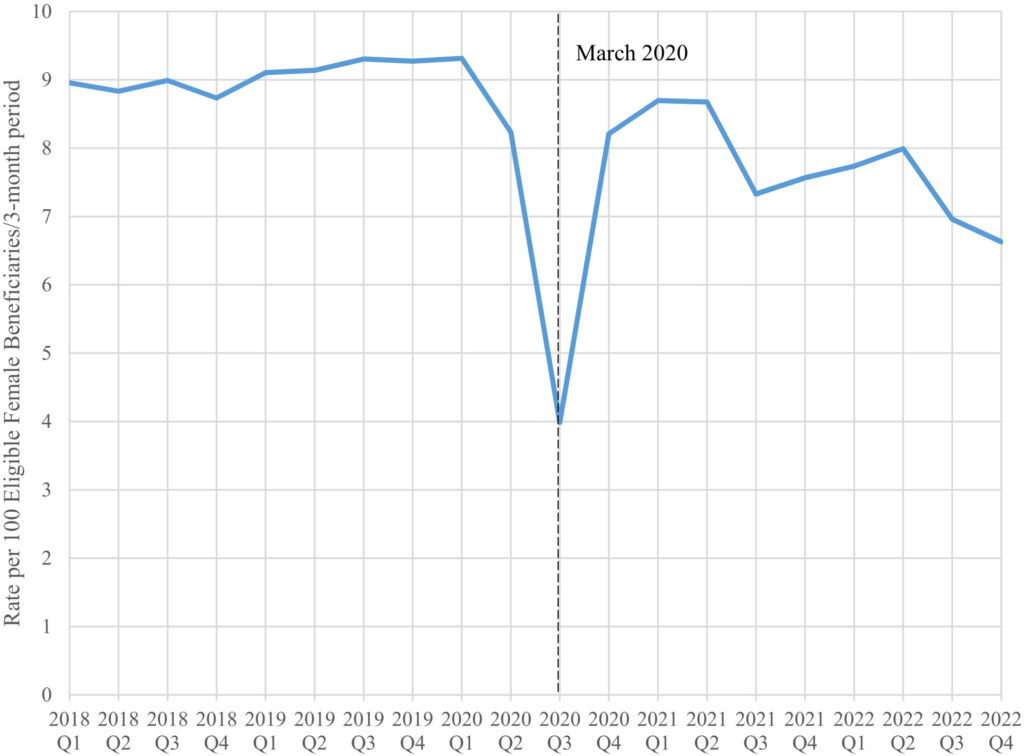
Click to Enlarge: Total quarterly mammography screening rates in the MHS, FY 2018–2022. Source: Cancer Medicine
BETHESDA, MD – Breast cancer screening within the Military Health System (MHS) plummeted by 74% in the early COVID-19 pandemic period and 22% in the late pandemic period, compared with the prepandemic period.
Less likely to receive screening during the SARS-CoV-2 outbreak were Asians/Pacific Islanders, American Indians/Alaskan Natives, and individuals from low socioeconomic backgrounds, according to the study led by researchers from the Uniformed Services University of the Health Sciences and the Henry M. Jackson Foundation for the Advancement of Military Medicine, Inc, both in Bethesda, as well as Brigham and Women’s Hospital and Harvard Medical School, both in Boston.
Background information in the article published in Cancer Medicine noted that, in the United States, breast cancer is the most commonly diagnosed cancer and the second leading cause of cancer death in women. “Early detection through mammogram screening is instrumental in reducing mortality and incidence of disease,” the authors wrote. “The COVID-19 pandemic posed unprecedented challenges to the provision of care, including delays in preventive screenings.”1
The study team examined trends in breast cancer screening during the COVID-19 pandemic in the MHS, a universally insured national population, and evaluated rates across racial groups and socioeconomic strata.
The retrospective open cohort study used the MHS Data Repository to identify female TRICARE beneficiaries ages 40-64 at average risk for breast cancer between FY2018 and FY2022. The records were divided into prepandemic – Sept. 1, 2018-Feb.28, 2020 –;, early pandemic — March 1, 2020-Sept. 30, 2020 — and late pandemic – Oct. 1, 2020-Sept. 30, 2022 – groups. Researchers were focused on the receipt of breast cancer screening.
In addition to the sharp drops in screening, results indicate that compared with white women, Asian/Pacific Islander women were less likely to receive mammograms during the late pandemic period (0.92RR; 0.90-0.93 95%CI). American Indian/Alaska Native women remained less likely to receive screenings compared with White women during the early (0.87RR; 0.80-0.94 95% CI) and late pandemic (0.94RR, 0.91-0.98 95% CI). Black women, on the other hand, had a higher likelihood of screenings during both the early pandemic (1.10RR; 1.08-1.12 95% CI) and late pandemic (1.12RR, 1.11-1.13 95% CI) periods compared with white women. “During the early and late pandemic periods, disparities by rank persisted from prepandemic levels, with a decrease in likelihood of screenings across all sponsor ranks,” the researchers advised.
“Our results indicate the influence of race and socioeconomics on mammography screening during COVID-19,” the study noted. “Targeted outreach and further evaluation of factors underpinning lower utilization in these populations are necessary to improve access to preventative services across the population.”
With breast cancer the most commonly diagnosed cancer and the second leading cause of cancer death in women in the United States, the condition accounted for about 290,000 new diagnoses and 43,000 deaths attributable to breast cancer in 2022, according to predictions.
“Early detection through mammogram screening has been instrumental in reducing the incidence of advanced stage disease and mortality,” according to the authors, who added that “women in lower socioeconomic brackets are less likely to get screened for breast cancer, and differences in the quality of care received during and after screening visits have been reported for racial and ethnic minorities.”
Further exacerbating pre-existing challenges was the COVID-19 pandemic because of restrictions on in-person evaluations and diversion of healthcare resources. “This redirection of resources led to delays and cancelations of nonurgent procedures and services,” the study recounted. “Across the board, there was a significant decrease in preventive screenings and early diagnosis of chronic conditions.”
In fact, the study team states that claims data in April 2020 showed an over 80% reduction in mammograms compared with February 2020. It said that the decrease in screening at the onset of the pandemic could have resulted in 36,000 delayed breast cancer diagnoses. “The challenges faced by the health care system during this period may have worsened existing disparities in access to health services, including many people who lost their health insurance as a result of job loss,” the researchers added.
The authors pointed out that the MHS uniquely provides healthcare to a universally insured population through the TRICARE plan, where beneficiaries can receive either direct care at military treatment facilities (MTFs) or in private civilian facilities where the plan serves as an insurance benefit. “This system minimizes several barriers often encountered in civilian health care settings that prevent individuals from accessing and utilizing medical services, and also mitigate racial disparities in cancer screenings,” according to the researchers.
The analysis showed overall reductions in mammograms among TRICARE beneficiaries in the early and late pandemic periods, although screening rates appeared to trend upward immediately after the initial decline. Still, the study found “worrisome and persistent reductions for several specific subgroups in the US demographic”.
“Although screening rates are trending back upward after the initial onset of COVID-19, important disparities persist for Asian/Pacific Islanders, American Indian/Alaskan Natives, and those in lower socioeconomic strata,” the authors added.
- Mani V, Banaag A, Munigala S, Umoh A, Schoenfeld AJ, Coles CL, Koehlmoos TP. Trends in breast cancer screening during the COVID-19 pandemic within a universally insured health system in the United States, 2017-2022. Cancer Med. 2023 Aug 28. doi: 10.1002/cam4.6487. Epub ahead of print. PMID: 37641528.

